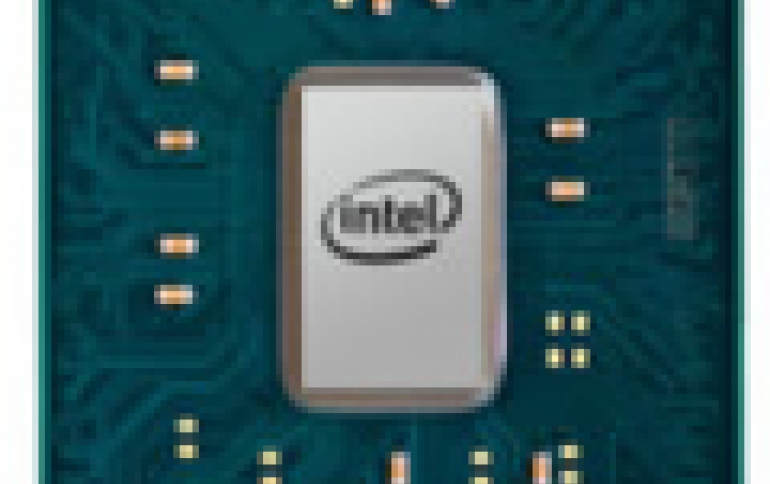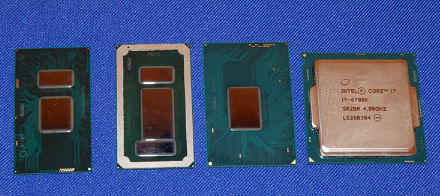
Intel Says New Skylake Processors Are The Best Ever Made
Today Intel officially introduced the 6th Gen Intel Core processor family, saying that they are the best processors ever. "6th Gen Intel Core processors deliver some of the most significant advancements in computing that we've ever seen," said Kirk Skaugen, Intel senior vice president and general manager of the Client Computing Group. "New 6th Gen Intel Core-based systems are more responsive than ever with enhanced performance, battery life and security. And they can enable amazing new PC experiences like logging into your computer with your face and having a personal assistant respond to your voice. The combination of 6th Gen Intel Core processors, Windows 10 and beautiful new systems from PC manufacturers make this the best time ever to buy a new computer."
Intel says that the 6th Gen Intel Core will offer up to two and a half times the performance, triple the battery life and even better graphics than any previous processor. They can also be half as thin and half the weight, have faster wake up time, and battery life that lasts virtually all day.
The new processors support a broad range of device designs – from the ultra-mobile compute stick, to 2 in 1s and huge high-definition All-in-One desktops, to new mobile workstations.

Built on the new Skylake microarchitecture on Intel's 14nm manufacturing process technology, the 6th Gen Intel Core processor family and Intel Xeon processors for mobile workstations will include 48 new processors:
- Five 4.5W Intel Core Y-series processors for small-screen 2 in 1 detachables and 2 in 1 convertibles.
- Ten 15W and four 28W Intel Core U-series processors for 2 in 1 convertibles and ultra-thin clamshells.
- Six 45W Intel Core H-series processors for thin clamshells and large-screen notebooks.
- One 45W Intel Core H-series unlocked mobile K SKU for enthusiast notebooks.
- Two 45W Intel Xeon processors for mobile workstations.
- Ten 65W and eight 35W Intel Core S-series processors for gaming towers, stationary All-in-Ones,
and mini PCs. - Two 91W desktop Intel Core S-series processors for overclockers and gaming enthusiasts.
The new 6th Gen Intel Core processor family and Intel Xeon for mobile workstations include the following:
- Intel Core m3, Intel Core m5 and Intel Core m5 vPro, Intel Core m7 and Intel Core m7 vPro
- Intel Core i3, Intel Core i5 and Intel Core i5 vPro, Intel Core i7 and Intel Core i7 vPro
- Intel Xeon E3-1500M v5


You can click on the following pictures to see detailed information about the new processors.
 |
 |
 |
 |
 |
 |
 |
 |
 |
 |
 |
Intel Core M processors, which can offer twice the performance of leading premium tablets, will now include brand levels Intel Core m3, m5 and m7 processors to provide people with more clarity and choice in finding the Intel Core M processor-based device that best meets their specific needs. The Intel Compute Stick lineup expands to include a version powered by the 6th Gen Intel Core M processor.
This new generation of Intel processors also includes several firsts for mobile designs: a mobile "K" SKU that is unlocked to enable overclocking with even more user control, a new quad-core Intel Core i5 processor that offers up to 60 percent improved mobile multitasking, and the Intel Xeon E3 processor family now powering mobile workstations. The 6th Gen Intel Core processors deliver significant improvements in graphics performance to offer great visuals for gaming as well as compelling 4K content creation and media playback. New Intel Speed Shift technology improves the responsiveness of mobile systems so people can, for example, apply a photo filter up to 45 percent faster.
In addition, the 6th Gen Intel Core and Intel Xeon platforms will offer a variety of new features and experiences. More devices will feature Thunderbolt 3 for USB Type-C, enabling one compact port that does it all. A user-facing or world-facing Intel RealSense Camera will be available on a range of new 6th Gen Intel Core processor-based 2 in 1s, notebooks and All-in-One desktop systems, offering new depth-sensing capabilities that allow people to do things like take and share lifelike 3-D selfies, scan objects and print in 3-D, and remove and change their background during a video chat.
The parts
Intel's new processor base designs come from five dies in four different packages. The terms 'Skylake-Y', 'Skylake-U', 'Skylake-H' and 'Skylake-S' are used as easy referrals and loosely define the power consumption and end product that these go in, but at the end of the day the YUHS designation can specifically segregate the size of the package (the PCB on which the die and other silicon sits). The YUHS processors all feature the same cores, the same graphics units, but differ in orientation and frequency.
Core M designs, which fall under Skylake’s Y-series, will be available in a 2+2 configuration only which is similar to the Broadwell offerings. Many of these processors will have a low base frequency and a high turbo mode to take advantage of burst performance. Also to note, DRAM support for Skylake-Y will be limited to LPDDR3/DDR3L, and will not include DDR4 support like the others.
Skylake-U also follows a similar path to previous Intel generations, being available in 15W and 28W versions. The extra 'e' means that these versions will also include Intel’s eDRAM solution which should be significantly useful when it comes to graphics performance. In previous eDRAM designs, this was only in available in 128MB variants, but for Skylake-U we will start to see 64MB versions.
The H processor family, such as Skylake-H, is typically found in high end notebooks or specific market devices such as all-in-ones where the ability to deal with the extra TDP (45W) is easier. Historically the H processor family is BGA only, meaning it can only be found in products soldered directly to the motherboard. Skylake-H will feature 45W parts with 4+2 and 4+4e configurations, the latter having 128MB of eDRAM. Also similarly to previous H designs, the chipset is external to the processor package.
Skylake-S represents everything desktop, including the K processors. Alongside the two 91W overclocking 'Skylake-K' parts, Intel will launch the regular 65W parts (e.g. i7-6700, i5-6600, i3-6100) and lower power 'Skylake-T' 45W (i7-6700T, i5-6600T, i3-6100T) parts as well. These will all have GT2 graphics, varying in frequency, as well as varying in cache sizes and some feature sets.
Launching secondary to the processors are the new Intel 100-series chipsets. Specifically, there will be desktop motherboard manufacturers announcing motherboards based on H170, B150, H110 and Q170 today, although which of these will be available when (for both desktop and other use) is not known. The business oriented chipsets will be the B150/Q1x0).

 |
 |
The 6th Gen Intel Core platform will also advance Intel's "no wires" initiative to deliver wireless displays with Intel WiDi or Pro WiDi. This technology allows people to share from their computer to a TV, monitor or projector without the mess of wires and dongles.
The 6th Gen Intel Core processor family helps optimize Windows 10 features such as Cortana and Windows Hello. Devices with the Intel RealSense Camera paired with Windows Hello let people securely log in using facial recognition. True Key technology by Intel Security is also available on many 6th Gen Intel Core processor-based systems to deliver a secure experience for logging into devices and websites without the need to remember each site's password.
In the coming months, Intel plans to deliver more than 48 processors in the 6th Gen Intel Core processor family, featuring Intel Iris and Iris Pro graphics, as well as Intel Xeon E3-1500M processor family for mobile workstations and 6th Gen Intel vPro processors for business and enterprises.






















